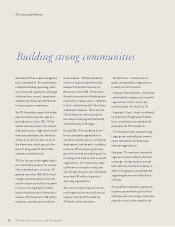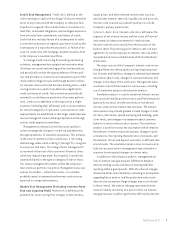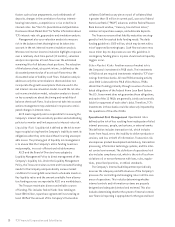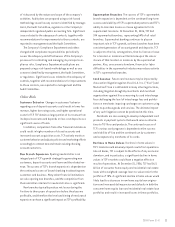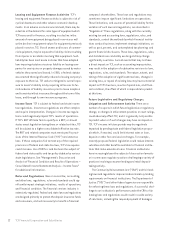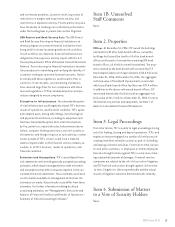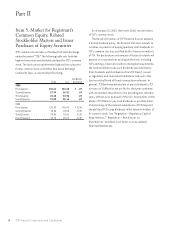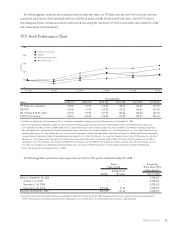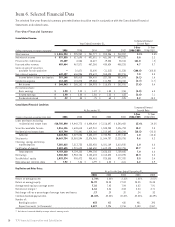TCF Bank 2006 Annual Report Download - page 28
Download and view the complete annual report
Please find page 28 of the 2006 TCF Bank annual report below. You can navigate through the pages in the report by either clicking on the pages listed below, or by using the keyword search tool below to find specific information within the annual report.
8TCF Financial Corporation and Subsidiaries
State Taxation TCF and/or its subsidiaries currently file
tax returns in all states which impose corporate income and
franchise taxes and local tax returns in certain cities and
other taxing jurisdictions. TCF’s primary banking activities
are in the states of Minnesota, Illinois, Michigan, Colorado,
Wisconsin and Arizona. The methods of filing, and the meth-
ods for calculating taxable and apportionable income, vary
depending upon the laws of the taxing jurisdiction. See
“Risk Factors.”
See “Management’s Discussion and Analysis of Financial
Condition and Results of Operations – Consolidated Income
Statement Analysis – Income Taxes” and Notes 1 and 12 of
Notes to Consolidated Financial Statements for additional
information regarding TCF’s income taxes.
Available Information
TCF’s website, www.tcfbank.com, includes free access to
Company news releases, investor presentations, conference
calls to discuss published financial results, TCF’s Annual
Report and periodic filings required by the Securities and
Exchange Commission (“SEC”), including annual reports on
Form 10-K, quarterly reports on Form 10-Q, current reports
on Form 8-K and amendments to those reports.
TCF’s Compensation/Nominating/Corporate Governance
Committee and Audit Committee charters, Corporate
Governance Guidelines, Codes of Ethics and changes to
Codes of Ethics are also available on this website.
Shareholders may request these documents in print by
contacting the Corporate Secretary at TCF Financial
Corporation, 200 Lake Street East, Mail Code EX0-03-A,
Wayzata, MN 55391-1693.
Item 1A. Risk Factors
Enterprise Risk Management
In the normal course of business, TCF is exposed to various
risks. Management balances the Company’s strategic goals,
including revenue and profitability objectives, with their
associated risks.
In defining the Company’s risk profile, management
organizes risks into three main categories: Credit Risk,
Market Risk (which includes interest-rate risk, liquidity
risk, and price risk) and Operational Risk (which includes
transaction risk and compliance risk). Policies, systems and
procedures have been adopted which are intended to iden-
tify, assess, control, monitor, and manage risk in each of
these areas.
Primary responsibility for risk management lies with the
heads of various business lines within the Company. Each
business line within the Company maintains policies, systems
and procedures which are intended to identify, assess, con-
trol, monitor, and manage risk within their respective areas.
Management continually reviews the adequacy and effec-
tiveness of these policies, systems and procedures.
As an integral part of the risk management process,
management has established various committees consist-
ing of senior executives and others within the Company.
The purpose of these committees is to closely monitor risks
and ensure that adequate risk management practices exist
within their respective areas of authority. Some of the princi-
pal committees include the Credit Policy Committee, Asset/
Liability Management Committee (“ALCO”), Investment
Committee, Capital Planning Committee and various financial
reporting and compliance-related committees. Overlapping
membership of these committees by senior executives and
others helps provide a unified view of risk on an enterprise-
wide basis.
To provide an enterprise-wide view of the Company’s
risk profile, an enterprise risk management governance
process has been established. This includes appointment
of an Enterprise Risk Management Officer, who oversees
the process and reports on the Company’s risk profile.
Additionally, risk officers are assigned to each significant
line of business and corporate function. The risk officers,
while reporting directly to their respective line or function,
facilitate implementation of the enterprise risk management
and governance process. An Enterprise Risk Management
Committee has been established consisting of senior execu-
tives and others within the Company, which oversees and
supports the Enterprise Risk Management Officer.
The enterprise risk management governance process
includes a process for providing an enterprise-wide view of
the identification, assessment, measurement, monitoring,
and reporting of significant risk-related events. The Board
of Directors, through its Audit Committee, has overall
responsibility for oversight of the Company’s enterprise risk
management governance process.


